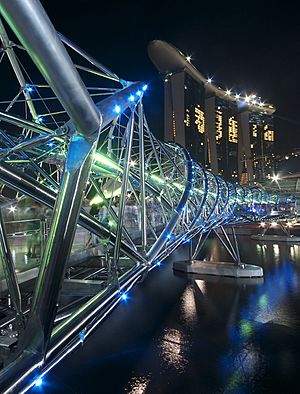The Helix Bridge facts for kids
Quick facts for kids Helix Bridge |
|
|---|---|

The Helix Bridge at night
|
|
| Carries | Pedestrians |
| Crosses | Marina Bay |
| Locale | Downtown Core, Singapore |
| Official name | The Helix |
| Owner | Urban Redevelopment Authority, Singapore |
| Characteristics | |
| Material | Stainless steel |
| Total length | 280 metres (920 ft) |
| History | |
| Architect | COX Group Pte Ltd (Australia) and Architects 61 (Singapore) |
| Designer | ARUP Pte Ltd (Australia) |
| Constructed by | Sato Kogyo Pte Ltd and TTJ Design and Engineering Pte Ltd |
| Construction begin | 2007 |
| Opened | 24 April 2010 |
The Helix Bridge, also known as The Helix, is a special bridge for people walking. It connects two areas in Singapore: Marina Centre and Marina South, both part of the beautiful Marina Bay. This unique bridge opened in two stages. Half of it opened on April 24, 2010, and the rest opened on July 18, 2010. It is located next to the Benjamin Sheares Bridge and the Bayfront Bridge.
Contents
What Makes the Helix Bridge Special?
The Helix Bridge was designed by a team of experts from Australia and Singapore. These teams included Cox Architecture, Arup, and Architects 61. They wanted to create a bridge that was both useful and amazing to look at.
Cool Design Features
The bridge has special covers made of glass and metal mesh. These covers give shade to people walking on the bridge. There are also four viewing platforms along the bridge. From these spots, you can see fantastic views of the Singapore skyline and events happening in Marina Bay.
At night, the bridge lights up! The lights show off its cool double-helix shape. This creates a stunning visual experience for everyone who visits.
A Bridge Like DNA
The design of the Helix Bridge is inspired by DNA, which is the building block of life. You can see pairs of colored letters, c and g, and a and t, lit up in red and green on the bridge. These letters stand for the four bases of DNA: cytosine, guanine, adenine, and thymine.
Interestingly, the bridge's design is a left-handed DNA helix. This is the opposite of how DNA usually twists in nature. Because of this unique feature, it was even added to "The Left Handed DNA Hall of Fame" in 2010!
Awards and Recognition
The Land Transport Authority of Singapore said that the Helix Bridge is a world-first in bridge design and engineering. It won the "World's Best Transport Building" award at the World Architecture Festival Awards in 2010. It also received an award for its design and safety in 2011 from the Building and Construction Authority (BCA).
How the Helix Bridge Was Built
Building the Helix Bridge was a big project that started in 2007. The bridge is made from about 650 tonnes of a strong material called Duplex Stainless Steel. Another 1000 tonnes of carbon steel were used for temporary structures during construction.
Building the Parts
Before building the actual bridge, the engineers made a test model out of carbon steel. This helped them find and fix any problems before they started on the real thing. The bridge parts were built in sections that could be moved easily on Singapore's roads. Each section was put together for a test run before being delivered to the building site. This made sure all the pieces fit perfectly.
Keeping it Clean
The special stainless steel used for the Helix Bridge can be easily damaged by dust from other metals. So, a special workshop was set up just for the bridge's parts. This kept them separate and clean from other types of steel.
Temporary Support Structures
A temporary bridge made of trusses was built first. This bridge supported the Helix Bridge during construction and allowed workers to access it. A big challenge was getting these trusses over the 50-meter wide navigation channel in the bay. This channel needed to stay clear for boats.
The trusses were lifted into place in sections at night using two large cranes. This helped avoid disturbing other users of the bay.
Putting the Bridge Together
Once the temporary bridge was ready, a mobile crane was used to lift the permanent parts of the Helix Bridge into place. The construction started from one end, adding the horizontal sections first. Then, the deck parts, cross members, and other pieces were bolted on.
Finally, the main helix structures were installed. The individual parts of the helices were carefully welded together. These connections were watched very closely to make sure the strong properties of the duplex steel were kept. After everything was in place, a special cleaning process was done to prevent rust.

